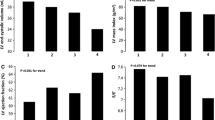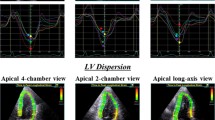Abstract
Purpose
Although alterations in longitudinal systolic function have been considered the earliest sign of cardiac damage, the importance of longitudinal fractional shortening (LFS), which reflects left ventricular longitudinal contraction, has not been studied in detail. We introduce a new method of measuring LFS by echocardiography and evaluate its efficiency.
Methods
Our study population consisted of 120 patients with diabetes mellitus (DM), 29 healthy volunteers, and 12 patients with coronary artery disease (CAD). LFS was assessed echocardiographically. Patients with DM underwent conventional echocardiography, assessment of left ventricular diastolic function, and pulsed-wave tissue Doppler study.
Results
LFS was 0.07 ± 0.02 in patients with CAD, 0.16 ± 0.05 in patients with DM, and 0.26 ± 0.04 in the normal controls. The three groups differed significantly with respect to the mean LFS values, which were significantly lower in patients with DM than in the normal controls. The ratio of peak diastolic velocities during early filling and atrial contraction (Em/Am) measured on pulsed-wave tissue Doppler images was significantly correlated with LFS (r = 0.37, P < 0.0001).
Conclusion
LFS is correlated with diastolic cardiac function and is a useful and sensitive index for evaluating long-axis systolic function.
Similar content being viewed by others
References
Teichholz LE, Kreulen T, Herman MV, et al. Problems in echocardiographic volume determinations: echocardiographic-angiographic correlations in the presence or absence of asynergy. Am J Cardiol 1976;37:7–11.
Quinones MA, Waggoner AD, Reduto LA, et al. A new, simplified and accurate method for determining ejection fraction with two-dimensional echocardiography. Circulation 1981;64:744–752.
Folland ED, Parisi AF, Moynihan PF, et al. Assessment of left ventricular ejection fraction and volumes by real-time, two-dimensional echocardiography. Circulation 1979;60:760–766.
Vasan RS, Levy D. Defining diastolic heart failure. A call for standardized diagnostic criteria. Circulation 2000;101:2118–2121.
Galderisi M. Diastolic dysfunction and diastolic heart failure: diagnostic, prognostic and therapeutic aspects. Cardiovasc Ultrasound 2005;3:9.
Kurita A, Shintani H. Sign of subendocardial ischemia on echocardiography. J Ultrasound Med 2006;25:287–288.
Alam M, Höglund C, Thorstrand C, et al. Haemodynamic significance of the atrioventricular plane displacement in patients with coronary artery disease. Eur Heart J 1992;13:194–200.
Vinereanu D, Ionescu AA, Fraser AG. Assessment of left ventricular long axis contraction can detect early myocardial dysfunction in asymptomatic patients with severe aortic regurgitation. Heart 2001;85:30–36.
Koulouris SN, Kostopoulos KG, Triantafyllou KA, et al. Impaired systolic dysfunction of left ventricular longitudinal fibers: a sign of early hypertensive cardiomyopathy. Clin Cardiol 2005;28:282–286.
Alam M, Höglund C, Thorstrand C. Longitudinal systolic shortening of the left ventricle: an echocardiographic study in subjects with and without preserved global function. Clin Physiol 1992;12:443–452.
Nagueh SF, Middleton KJ, Kopelen HA, et al. Doppler tissue imaging: a noninvasive technique for evaluation of left ventricular relaxation and estimation of filling pressures. J Am Coll Cardiol 1997;30:1527–1533.
Nikitin NP, Witte KK, Thackray SD, et al. Longitudinal ventricular function: normal values of atrioventricular annular and myocardial velocities measured with quantitative two-dimensional color Doppler tissue imaging. J Am Soc Echocardiogr 2003;16:906–921.
Herman MV, Heinle RA, Klein MD, et al. Localized disorders in myocardial contraction: asynergy and its role in congestive heart failure. N Engl J Med 1967;277:222–232.
Nikitin NP, Witte KK, Ingle L, et al. Longitudinal myocardial dysfunction in healthy older subjects as a manifestation of cardiac ageing. Age Ageing 2005;34:343–349.
Vinereanu D, Nicolaides E, Tweddel AC, et al. “Pure” diastolic dysfunction is associated with long-axis systolic dysfunction. Implications for the diagnosis and classification of heart failure. Eur J Heart Fail 2005;7:820–828.
Yip G, Wang M, Zhang Y, et al. Left ventricular long axis function in diastolic heart failure is reduced in both diastole and systole: time for a redefinition? Heart 2002;87:121–125.
Onose Y, Oki T, Mishiro Y, et al. Influence of aging on systolic left ventricular wall motion velocities along the long and short axes in clinically normal patients determined by pulsed tissue Doppler imaging. J Am Soc Echocardiogr 1999;12:921–926.
Greenbaum RA, Ho SY, Gibson DG, et al. Left ventricular fiber architecture in man. Br Heart J 1981;45:248–263.
Lunkenheimer PP, Redmann K, Florek J, et al. The forces generated within the musculature of the left ventricular wall. Heart 2004;90:200–207.
Andersen NH, Poulsen SH, Eiskær H, et al. Decreased left ventricular longitudinal contraction in normotensive and normoalbuminuric patients with type II diabetes mellitus: a Doppler tissue tracking and strain-rate echocardiography study. Clin Sci 2003;105:59–66.
Sohn DW, Chai IH, Lee DJ, et al. Assessment of mitral annulus velocity by Doppler tissue imaging in the evaluation of left ventricular diastolic function. J Am Coll Cardiol 1997;30:474–480.
Willenheimer R, Cline C, Erhardt L, et al. Left ventricular atrioventricular plane displacement: an echocardiographic technique for rapid assessment of prognosis in heart failure. Heart 1997;78:230–236.
Author information
Authors and Affiliations
Corresponding author
About this article
Cite this article
Kurita, A., Itoh, H., Sato, F. et al. Longitudinal fractional shortening and its relation to diastolic cardiac function. J Med Ultrasonics 35, 113–118 (2008). https://doi.org/10.1007/s10396-008-0176-0
Received:
Accepted:
Published:
Issue Date:
DOI: https://doi.org/10.1007/s10396-008-0176-0




